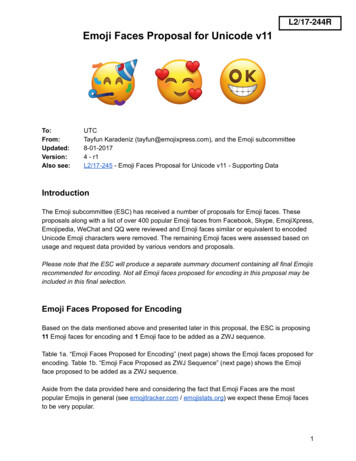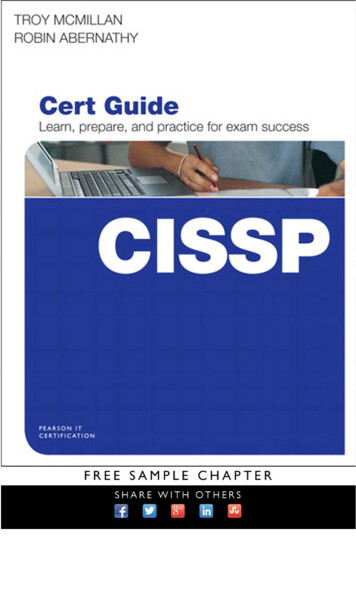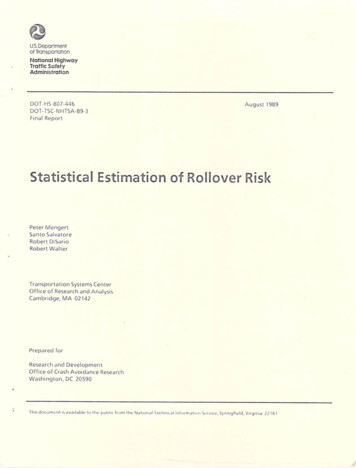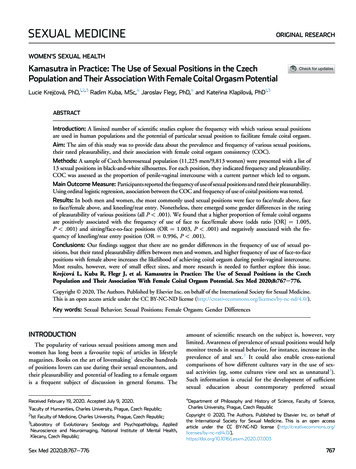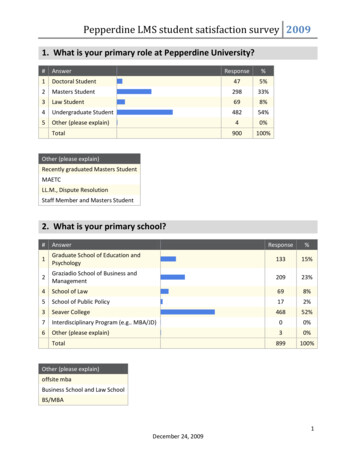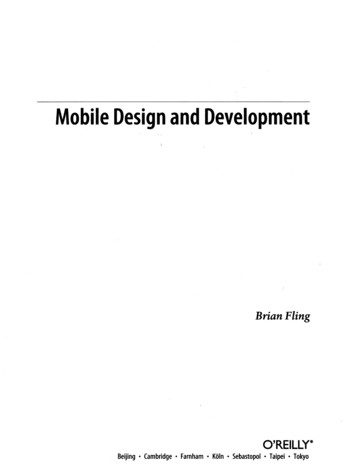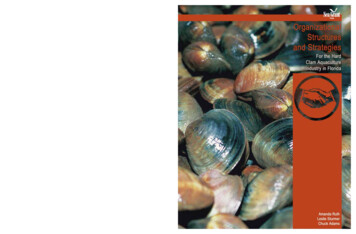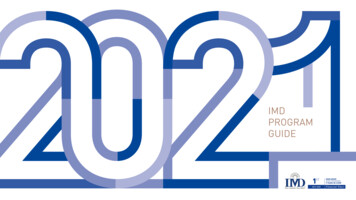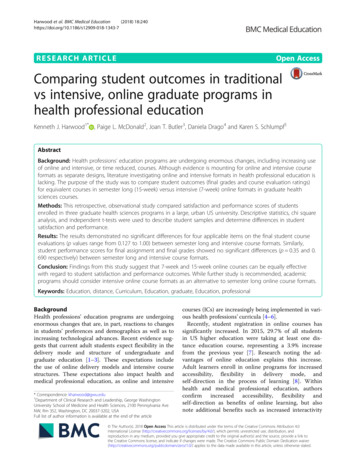
Transcription
Personalised Learning. Diverse Goals. One Heart.FULL PAPERSOnline Versus Face-to-Face: A Quantitative Study ofFactors Influencing Students’ Choice of Study Mode usingChi-Square Test and Binary Logistic RegressionSze-Kiu YeungSingapore University of Social SciencesSingaporeWee Leong LeeSingapore University of Social SciencesSingaporeFor online learning in the January 2019 semester, students at the Singapore University of SocialSciences were able to choose whether they want to study in virtual or face-to-face mode in twocourses. Virtual refers to full online learning whereby students study, in a six-week term,without the need to meet face-to-face with the instructor while face-to-face refers to blendede-learning whereby students received either six or three face-to-face lessons with e-learningresources. In full online mode, students will meet the instructor virtually via videoconferencing on a weekly basis. Data were obtained to find out which variables actually hadan effect of students’ choice of learning mode. 370 students were analysed and the variablesincluding gender, marital status, race, nationality, course, qualification, school, programme,intake, age (now), age (joint) and cumulative grade point average (CGPA) were examined.Each variable was compared with the students’ mode of study in order to identify if they aredependent (e.g. gender versus study mode, race versus study mode, etc.) based on a chi-squaretest. The significant variables were further investigated using a binary logistic regressionmodel. It was found that qualification, intake and CGPA were found to be significant forstudents’ choice of learning.Keywords: Virtual, Face-to-face, Mode of study, Chi-square test, Binary logistic regressionIntroductionTwo courses, Customer Relationship Management (BUS354) and Starting and Managing a Business (BUS357),offered by the School of Business provided two modes of study for students to undertake in the semester ofJanuary 2019. One was virtual whereby the students learned online with virtual face-to-face interactions with theirinstructors and peers while the other being physical face-to-face based on the blended e-learning approach ofcombining either six or three face-to-face lessons with e-learning contents over a term of six weeks. Studentstaking these courses were studying part-time taking classes in the evening and they had the option to choose theirmode of study. All students taking these courses will take a common examination at the end, but the continuousassessment components will be different. Data from the Student Information Systems provided students’background information including demographic and academic details. 370 students were analysed and thevariables that was extracted would include gender, marital status, race, nationality, course, qualification, school,programme, intake, age (now), age (joint) and cumulative grade point average (CGPA). The purpose of this paperwas to find out from the data if there were significant variables that influenced students’ choice of study. Insightsdrawn from this study will be helpful in planning for course offering in various modes. We believed the statisticalanalyses of the chi-square test and the binary logistic regression would be appropriate to obtain the findings forthis study.Literature ReviewOnline and face-to-face learning have been studied widely. Researchers had found that for online students theyare usually older, have full or part-time work, requires commuting to the campus, have family obligations andhave taken online courses before. Cleveland, Dutcher & Epps (2015) explained in their study that “online studentstend to be older, part or full time workers, and returning to school after being in the working world” while thestudents in their survey who took the face to face “tended to be the more traditional college student: younger,often directly out of high school” (p. 128). On the other hand, face-to-face students are usually freshmen and theylike to seek interactions with their instructors and classmates in the physical classroom. Dendir (2016) found that“the average online student was a sophomore, whereas the typical face-to-face student was a freshman . a closerlook at the data shows that 83% of the sample in the face-to-face section were freshmen, whereas about 77% inthe online sample were sophomore and above . a majority of the online students (58%) had prior experiencewith online courses” (p. 62). The key to online study is the flexibility and convenience to learn at the students’own pace and when they are most productive as pointed out by Jaggers (2014) “that convenience and flexibilityASCILITE 2019 Singapore University of Social Sciences340
Personalised Learning. Diverse Goals. One Heart.FULL PAPERSare key factors that entice students to enroll in online coursework” (p. 27). In terms of student characteristics, itwas found that “student age, percentage female, race and grade point average (GPA)” had no differences by themode of delivery (Parcel, Radu & Gonzales, 2018, p.4). This study, based on two courses that allowed studentsto choose between either online or face-to-face mode, attempts to determine which independent variables affectedstudents’ choice of learning.Research QuestionBased on the independent variables obtained for this study, would there be a significance between eachindependent variable compared to the mode of learning (i.e. the dependent variable) for the students who studiedin BUS354 and BUS357? Would there also be interactions between these independent variables?Chi-square Test and the Binary Logistic Regression ModelThe use of the chi-square test and the binary logistic regression model as statistical tests came about from papersdiscussing the analysis of dependent variable in binary form. They included the studies of integrated pestmanagement (IPM) adoption (Talukder, Sakib & Islam, 2017), drivers’ reactions in car crashes (Al-Taweel,Young & Sobhani, 2016) and stillbirths in Ethiopia (Berhie & Gebresilassie, 2016). These papers analysed thebinary nature of the dependent variable (see Table 1) against a range of independent variables.Table 1: Dependent Variables in Binary FormatDependent VariableIPM AdoptionDrivers’ ReactionsExperienced StillbirthCategory1: Yes, 0: No1: Drivers take Reactions, 0: Drivers do not take Reactions1: Yes, 0: NoGiven that all the independent variables are in categorical format, the use of the chi-square test to determine thesignificance of the variables with the binary dependent variable made statistical sense. To further identify thelevels of each independent variable such that there is significance associated with the dependent variable, thesepapers suggested the use of the binary logistic regression model. For example, are there significance associationsbetween IPM adoption and different regions (Talukder et al., 2018), divers’ reactions and crash type (Al-Taweelet al., 2016) and experiencing stillbirth and maternal age (Berhie & Gebresilassie, 2016). The key question foreach study was to determine if there was IPM adoption, drivers take reactions or experiencing stillbirth amongdifferent levels of independent variables. From these studies, it was established that a consistent statisticalapproach using the chi-square test and the binary logistic regression model to determine if students’ choice oflearning (virtual or face-to-face) was significant against a selection of independent variables would be valid.Details about the binary logistic regression model are explained in the journals from Peng, Lee & Ingersoll (2002)and Sperandei (2013).Interpreting Results from the Binary Logistic Regression ModelIn terms of interpreting the results of the binary logistic regression model, an understanding on the use of the oddsratio (OR) is important (Strand, Cadwallader & Firth, 2011). By definition, an OR ‘compares the odds of success(or failure) for a particular group to a base (reference) category for that variable’ (Strand el al., 2011, p. 18). Forexample, if we evaluate ethnicity and higher academic results according to Table 2, we note that White Britishstudents have been selected as the reference category. Indian students are 1.58 times more likely than WhiteBritish students to achieve higher academic results or they are 58% more likely to achieve higher academic resultsthan White British students. Conversely for Black Caribbean students the OR is 0.53, so Black Caribbean studentsare less likely to achieve higher academic results compared to White British students. In percentage terms theyare 47% less likely to achieve higher academic results. What this means is that Indian students are more likelywhile Black Caribbean are less likely compared to White British students on achieving higher academic results.In SPSS, OR is represented by the ‘Exp(B)’ ratio.ASCILITE 2019 Singapore University of Social Sciences341
Personalised Learning. Diverse Goals. One Heart.FULL PAPERSTable 2: Ethnicity and Higher Academic ResultsEthnicity0 White British1 Mixed Heritage2 Indian3 Pakistani4 Bangladeshi5 Black Caribbean6 Black African7 OthersOR (for Higher Academic Results)Reference Category0.871.580.640.800.530.811.21With an understanding on interpreting the results of the binary logistic regression model, it was possible todetermine which levels of the independent variables were significant and were more likely or less likely comparedto the reference category with respect to students’ mode of study (i.e. virtual or face-to-face).MethodologyThe status of students’ mode of study (1 for virtual, 0 for face-to-face) was considered as the main variable ofinterest (i.e. the dependent variable). If the student had chosen to study in full online learning, then he/she wasconsidered as a virtual student otherwise face-to-face. At the same time, a list of other demographic characteristics(also considered variables) for students was also captured. These independent variables included gender, maritalstatus, nationality, course, school, race, qualification, programme, intake, age (now), age (joint, i.e. when joiningSUSS) and cumulative grade point average (CGPA). The question of interest was to determine which of theseindependent variables affected students’ mode of study in terms of learning in virtual or face-to-face mode and, ifpossible, the interactions among them. Table 3 provides a listing of the variables and its category.Table 3: Variables Selected in Relation to Students’ Mode of StudyVariableDependentStudy ModeIndependentGenderMarital StatusNationalityRaceAge (Now)Age ACategory1: Virtual, 0: Face-to-face1:Male, 2: Female1: Single, 2: Married or Divorced1: Singaporean, 2: Others1: Chinese, 2: Malay, 3: Indian, 4: Others1: 30, 2: 30 to 39, 3: 401: 30, 2: 30 to 39, 3: 401: BUS354, 2: BUS3571: Business, 2: Others1: BSBZ, 2: BSMA, 3: Others1: Diploma, 2: A-levels, 3: Others1: 2012/01 to 2014/07, 2: 2015/01 to 2017/07, 3: 2018/01 to 2019/011: 2.00, 2: 2.01 to 3.00, 3: 3.00Statistical AnalysisTo assess students’ mode of learning in either virtual or face-to-face mode, a statistical analysis involvingunivariate, bivariate and multivariate setup were conducted. In the bivariate setup, a chi-square test was used toassess the significance between the dependent and independent variables. In the multivariate setup, the binarylogistic regression model was used to determine the likelihood of study mode (virtual or face-to-face) with theabove independent variables that were found to be significant from the chi-square test. The software that was usedfor the analysis of data is SPSS (Version 22 for Windows).ASCILITE 2019 Singapore University of Social Sciences342
Personalised Learning. Diverse Goals. One Heart.FULL PAPERSResults and DiscussionsUnivariate AnalysisAmong the 370 students, 42% were male and 58% female. The average age of students at intake was 26 and theage groups at intake were broken into three categories: less than 30 (82.2%), 30 to 39 (11.1%) and equal or higherthan 40 (6.8%). The majority was single (81.1%) with married or divorced at 18.9%. In terms of race andnationality, the majority was Chinese (79.7%) with Malay (10.5%), Indian (6.2%) and Others (3.5%) as the otherraces and Singaporean (97.6%) was the majority nationality with the minority being other nationalities (2.4%).More students have studied BUS357 (57.8%) compared to BUS354 (42.2%) and they mostly studied in the Schoolof Business (87.3%) compared to other schools (12.7%). The programmes that the students studied were evenlydistributed between Bachelor of Business (BSBZ) (44.5%) and other programmes (42.8%) with the remainingstudents taking Bachelor of Marketing (BSBM) (12.7%). Qualification-wise, the majority of these students had aDiploma (73.2%) with A-levels (8.1%) and others (18.6%) as the remaining qualifications. For semester-intakesthey were broken down into three periods: January 2012 to July 2014 (10%), January 2015 to July 2017 (75.4%)and January 2018 to January 2019 (14.6%). In term of the students’ Cumulative Grade Point Average (CGPA)they were based on three ranges: less than or equal to 2.00 (10%), 2.01 to 3.00 (36.5%) and higher than 3.00(53.5%). Finally, for the dependent variable of mode of study, the majority of students had chosen to study ‘faceto-face’ (87.6%) with the remaining students opted for ‘virtual’ (12.4%). Table 4 shows a summary of thesestatistics.Table 4: Summary StatisticsVariableGenderMaleFemaleAge (Joint) 3030 to 39 40Marital StatusSingleMarried or SBMOthersIntake2012/01 to 2014/072015/01 to 2017/072018/01 to 4715844.612.742.7372795410.075.414.6ASCILITE 2019 Singapore University of Social Sciences343
Personalised Learning. Diverse Goals. One Heart.CGPA 2.002.01 to 3.00 3.00Study ModeVirtualFace-to-FaceFULL PAPERS3513519810.036.553.54632412.487.6Bivariate AnalysisBased on the chi-square test of independence for categorical variables, the following hypotheses were evaluated: Null Hypothesis (H0): the two categorical variables were independent (i.e. there was no relationship betweenthem); Alternative Hypothesis (H1): the two categorical variables were not independent (i.e. there was a relationshipbetween them and that they were significantly related).H0 was rejected if the Pearson chi-square had p-value 0.05 or 0.10, meaning that statistically the two variableswere significant.As shown in Table 5, the independent variables that were reportedly to be highly significant (p 0.05 or 0.01) orsignificant (p 0.10) with the dependent variable (i.e. study mode) were qualification, programme, intake, age(joint) and CGPA. The chi-square test showed that these five independent variables were correlated with thedependent variable. On students’ qualification, those with A-levels (26.7%) had opted to study in ‘virtual’ morethan those with diploma (12.2%) and other qualifications (7.2%). The marketing programme (23.4%) was morepopular with ‘virtual’ students compared to business (11.5%) and other programmes (10.1%). Intake-wise, thelatest semester-intakes of January 2018 to January 2019 had a higher proportion (27.8%) of ‘virtual’ studentscompared to the first semester-intakes (January 2012 to July 2014) (21.6%) and the second semester-intakes(January 2015 to July 2017) (8.2%). For students’ age (joint), those who were ‘40 ’ had the highest percentageof virtual learners (24.0%) compared to those who were aged ‘less than 30’ (12.5%) and between ‘30 to 39’(4.9%). As for the CGPA, the proportion of ‘virtual’ students were higher in the ‘less than or equal to 2.00’ group(29.7%) compared to ‘2.01 to 3.00’ (16.3%) and ‘greater than 3.00’ (6.6%). On the other hand, the other sevenindependent variables (gender, marital status, race, nationality, course, school and age (now)) do not havesignificant effect on students’ mode of study given that the Pearson chi-square test was p 0.10.ASCILITE 2019 Singapore University of Social Sciences344
Personalised Learning. Diverse Goals. One Heart.FULL PAPERSTable 5: Assessing Association between Study Mode and Independent Variables with P values from Chisquare TestIndependent VariableStudy Mode(n 370)Virtual (%)GenderMale21 (13.5)Female25 (11.6)Marital StatusSingle37 (12.3)Married or Divorced9 (12.9)RaceChinese38 (12.9)Malay5 (12.8)Indian2 (8.7)Others1 (7.7)NationalitySingaporean44 (12.2)Others2 (22.2)CourseBUS35416 (10.3)BUS37530 (14.0)QualificationDiploma33 (12.2)A-Levels8 (26.7)Others5 (7.2)SchoolBusiness40 (12.4)Others6 (12.8)ProgrammeBSBZ19 (11.5)BSBM11 (23.4)Others16 (10.1)Intake2012/01 to 2014/078 (21.6)2015/01 to 2017/0723 (8.2)2018/01 to 2019/0115 (27.8)Age (Now) 3035 (12.7)30 to 395 (8.6) 406 (16.2)Age (Joint) 3038 (12.5)30 to 392 (4.9) 406 (24.0)CGPA 2.0011 (29.7)2.01 to 3.0022 (16.3) 3.0013 (6.6)***p value 0.01, **p value 0.05, *p value 0.10ASCILITE 2019 Singapore University of Social SciencesP ValueFace-to-Face (%)0.581134 (86.5)190 (88.4)0.905263 (87.7)61 (87.1)0.891257 (87.1)34 (87.2)21 (91.3)12 (92.3)0.368317 (87.8)7 (77.8)0.279140 (89.7)184 (86.0)0.026**238 (87.8)22 (73.3)64 (92.8)0.941283 (87.6)41 (87.2)0.047**146 (88.5)36 (76.6)142 (89.9)0.000***29 (78.4)256 (91.8)39 (72.2)0.527240 (87.3)53 (91.4)31 (83.8)0.073*266 (87.5)39 (95.1)19 (76.0)0.000***26 (70.3)113 (83.7)185 (93.4)345
Personalised Learning. Diverse Goals. One Heart.FULL PAPERSBinary Logistic Regression AnalysisWe used the binary logistic regression model with the significant variables found in the bivariate analysis (seeTable 5) to determine students’ mode of study. The results are shown in Table 6. We noted that the independentvariables of qualification (p 0.098 0.1), intake (p 0.025 0.05) and CGPA (p 0.007 0.01) had significanteffect on students’ mode of study. For qualification, students with A-levels were almost twice (188%) more likelyto take up virtual learning (OR 2.875) compared to diploma holders (reference category). Students fromsemester-intakes of January 2015 to July 2017 were less likely (59%) to take virtual than those from the January2012 to July 2014 (reference category) (OR 0.407). In terms of students’ CGPA, those with ‘greater than 3.0’was less likely (77%) to take virtual than those from the ‘less than or equal to 2.00’ group (reference category)(OR 0.228). However, programme and age (joint) were found not to have significant effect (p 0.1) on students’mode of study even though it did have significant association from the bivariate analysis.Table 6: Binary Logistic Regression Model for Students’ Mode of Study ficationLevelCoefficientOdds Ratio(Exp(B))DiplomaA-LevelsOtherReference Category1.0562.8750.0301.030BSBZBSBMOtherReference luetoReference Categoryto-0.8990.4070.072*to0.1601.1740.772Age (Joint)0.121 3030 to 39 40Reference Category-1.2270.2930.6241.867CGPA 2.002.01 to 3.00 3.00***p value 0.01, **p value 0.05, *p value 0.100.1140.2500.007***Reference Category-0.5010.606-1.4790.2280.2930.004***In terms of the interactions between the independent variables, they were analysed according to, firstly, Age (Joint)by Marital Status, and Age (Joint) by Gender, since we thought female students who were at child bearing age orwho were raising a family would choose virtual learning. Secondly, other independent variables were randomlyselected to obtain the interaction results and they included Age (Joint) by CGPA, Age (Joint) by Qualification,Intake by Gender and CGPA by Qualification. Except for Intake by Gender, all interactions were not significant(see Table 7).ASCILITE 2019 Singapore University of Social Sciences346
Personalised Learning. Diverse Goals. One Heart.FULL PAPERSTable 7: Interaction between Independent VariablesIndependent VariableQualificationProgrammeIntakeAge (Joint)CGPAAge (Joint) * Marital StatusAge (Joint) * GenderAge (Joint) * CGPAAge (Joint) * QualificationIntake * GenderCGPA * 1.0000.9931.0000.0190.976ConclusionThe chi-square test revealed that the independent variables of qualification, programme, intake, age (joint) andCGPA were found to be significant (p 0.10) and that the bivariate analysis showed students have the highestpercentage of virtual learning for A-levels (26.7%), marketing (23.4%), intake between January 2018 to January2019 (27.8%), age (joint) of ‘40 ’ (24.0%) and CGPA ‘less than or equal to 2.00’ (29.7%). At the same time, thebinary logistic regression model was used to analyse the adjusted effect of the levels from these independentvariables (see Table 6). For qualification, A-levels holders were more likely (OR 2.875) to take virtual learningcompared to students with diploma (reference category) by 188%. On the other hand, students from the ‘January2015 to July 2017’ intake were less likely (OR 0.407) to take virtual learning compared to ‘January 2012 to July2014’ (reference category) by 59% and those with CGPA of ‘higher than 3.00’ were less likely (OR 0.228)against the reference category of ‘less than or equal to 2.00’ by 77%. For programme and age (joint), togetherwith the other seven independent variables from the chi-square test (gender, marital status, race, nationality,course, school, age (now)), they had no significant effect on students’ mode of study (p 0.5). In conclusion, thelevels that had an effect on students’ choice of virtual learning were A-level holders, those admitted betweenJanuary 2012 to July 2014, and students with CGPA of ‘less than or equal to 2.00’ while the interaction effectswere minimum. Compared to the literatures this study confirmed that older students (based on intake data) had apreference for virtual learning. In terms of the paper’s usefulness to learning and teaching, for older students invirtual learning a balanced use of technology (i.e. not overwhelming) would be suitable. The limitation of thisstudy was that they were based on two courses. Data on current work experience would also be helpful since parttime students would work either part-time or full-time. Also, students’ experience of other online courses wouldbe helpful as well. In short a data-set with these additional variables would be more helpful but for this study thevariables obtained are based on those shown in Table 3. Given that these two courses were offered as both ‘virtual’and ‘face-to-face’ formats, this study, based on the data available, determined what variables influenced students’mode of learning according to the findings from the chi-square test and the binary logistic regression.ReferencesAl-Taweel, H. M. H., Young, W., & Sobhani, A. (2016). A Binary Logistic Regression Model for the DriverAvoidence Manoeuvers in Tow Passenger Vehicle Crashes. Australasian Transport Research Forum (ATRF),38, 2016.Berhie, K. A., & Gebresilassie, H. G. (2016). Logistic Regression Analysis on the Determinants of Stillbirth inEthiopia. Maternal Health, Neonatology and Perinatology (2016) 2:10. DOI: 10.1186/s40748-016-0038-5Cleaveland, M. C., Dutcher, C., & Epps, K. (2015). Comparing Business Law in Online and Face-to-FaceFormats: A Difference in Student Learning Perception. Academy of Educational Leadership Journal, Vol 19(1), 2015.Dendir, S. (2016). An online premium? Characteristics and performanceof online versus face-to-face students in Principles of Microeconomics. Journal of Education forBusiness (2016), 91:2, 59-68, DOI: 10.1080/08832323.2015.1110555Jaggars, S. S. (2014). Choosing Between Online and Face-to-FaceCourses: Community College Student Voices. American Journal of Distance Education (2014), 28:1, 27-38, DOI:10.1080/08923647.2014.867697Parcel, T. L., Radu, M. B., & Gonzales, L. F. (2018). Who Selects an Online Class Over the Same Course Faceto-Face? And Who Learns More? Results from a Mixed-Methods, Quasi-Experimental Study of Teaching theASCILITE 2019 Singapore University of Social Sciences347
Personalised Learning. Diverse Goals. One Heart.FULL PAPERSSociology of Work and Family. The Journal of Public and Professional Sociology (2018): Vol. 10: Issue 1,Article 6.Peng, C. J., Lee, K. L., & Ingersoll, G. M. (2002). An Introduction to Logistic Regression Analysis and Reporting.The Journal of Education Research. Vol 96 (1), 2002.Sperandei, S. (2014). Understanding Logistic Regression Analysis. Biochemia Medica 2014; trand, S., Cadwallader, C., & Firth, D. (2011). Using Statistical Regression Methods in Education Research.ESRC National Centre for Research Methods, University of Southampton, 2011. Retrieved research-new/srme/index.htmlTalukder, A., Sakib, M. S., & Islam, M. A. (2017). Determination of Influencing Factors for Integrated PestManagement Adoption: A Logistic Regression Analysis. Agrotechnology 6: 163. DOI: 10.4172/21689881.1000163Please cite as: Yeung, S.K. & Lee, W.L. (2019 Online Versus Face-to-Face: A Quantitative Study of FactorsInfluencing Students’ Choice of Study Mode using Chi-Square Test and Binary Logistic Regression. In Y.W. Chew, K. M. Chan, and A. Alphonso (Eds.), Personalised Learning. Diverse Goals. One Heart. ASCILITE2019 Singapore (pp. 340-348).ASCILITE 2019 Singapore University of Social Sciences348
Chi-Square Test and Binary Logistic Regression Sze-Kiu Yeung Wee Leong Lee Singapore University of Social Sciences Singapore University of Social Sciences . In SPSS, OR is represented by the 'Exp(B)' ratio. Personalised Learning. Diverse Goals. One Heart. FULL PAPERS ASCILITE 2019 Singapore University of Social Sciences 342
